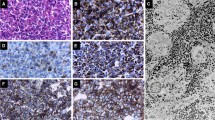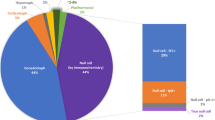Abstract
To compare the pituitary pathology of gigantism to that of acromegaly, 19 surgically resected lesions were studied from 10 males and 9 females, ages 13–49 (mean, 19 yr) with excessive height (≥95th percentile), onset of disease prior to puberty, elevated growth hormone (GH) levels despite glucose suppression, and a pathologically confirmed GH-producing pituitary mass. One patient had MEN-I. The lesions included 18 adenomas and 1 case of pure hyperplasia. The median, mean, and range of serum GH and prolactin (PRL) levels were 64, 235, 5–1000 ng/mL and 47, 146, 29–770 ng/mL, respectively. Of the 8 adenoma specimens accompanied by nontumoral pituitary (i.e., tissue wherein the presence of hyperplasia was assessable), 3 (37%) demonstrated both. Of the 18 tumors, 78% were macroadenomas and 22% were grossly invasive; their immunophenotypes included GH (5%), GH and PRL (19%), and GH-PRL and a glycoprotein hormone, usually TSH and/or α-subunit (76%). Of the 10 adenoma-containing lesions subject to electron microscopy (EM), 2 consisted of GH cells alone; 2 of mammosomatotroph (MS) cells alone; 1 of GH and MS cells; 1 of GH and PRL cells; 2 of GH, PRL, and MS cells; 1 of GH, PRL, and glycoprotein cells; and 1 was a subtype 3 adenoma. Ultrastructurally, GH cells and/or MS cells predominated in these lesions. Immuno-EM of one GH and PRL cell and of one GH-PRL-MS tumor showed GH and PRL to be present not only in single cells but within the same granules. Nine of 12 adenoma-associated lesions subject to combinedin situ hybridization (ISH) and immunostaining showed double labeling for PRL (or GH) mRNA and for GH (or PRL), respectively, features indicating MS differentiation. In the 4 lesions exhibiting hyperplasia, either alone (1) or in association with adenoma (3), EM showed MS cells in 3, and immuno-EM as well as combined immunohistochemistry and ISH showed double labeling for GH and PRL in both of the 2 cases studied. In summary, although in terms of their tinctorial characteristics and tumor size, the lesions of giants resemble those of acromegalics, those of the former are less often invasive and glycoprotein hormone containing, and more often contain ultrastructurally distinctive MS cells. The high frequency of adenoma with hyperplasia (37%) and the occurrence of hyperplasia alone (6%) is of particular notice since this finding is rare in patients with acromegaly. Hyperplasia is, however, seen in ectopic GH-releasing hormone production and the McCune-Albright syndrome. We conclude that the presence of MS is not rare in the pituitary lesions of patients with gigantism. Their presence may be a reflection of either hypothalamic dysfunction or of an intrinsic abnormality of pituitary cells.
Similar content being viewed by others
References
Kane LA, Leinung MC, Scheithauer BW, et al. Pituitary adenomas in childhood and adolescence: a clinicopathologic study of the Mayo Clinic experience. Endocrine Pathol 3(Suppl.):117, 1992.
Horvath E, Kovacs K. Fine structural cytology of the adenohypophysis in rat and man. J Electron Microsc Techn 8:401–432, 1988.
Kovacs K, Horvath E, Losinski N. Mammosomatotrophs in nontumorous and adenomatous rat pituitaries: an immunoelectron microscopic study. Exp Clin Endocrinol 7:109–113, 1988.
Lloyd RV, Anagnostou D, Cano M, Barkan AL, Chandler WF. Analysis of mammosomatotropic cells in normal and neoplastic human pituitary tissues by the reverse hemolytic plaque assay and immunocytochemistry. J Clin Endocrinol Metab 66:1103–1110, 1988.
Scheithauer BW, Sano T, Kovacs K, et al. The pituitary gland in pregnancy: a clinicopathologic and immunohistochemical study of 69 cases. Mayo Clin Proc 65:461–474, 1990.
Stefaneanu L, Kovacs K, Lloyd R, et al. Pituitary lactotrophs and somatotrophs in pregnancy: a correlative in situ hybridization and immunocytochemical study. J Clin Endocrinol Metab 62:291–296, 1992.
Kovacs K, Horvath E, Thorner MO, Rogol D. Mammosomatotroph hyperplasia associated with acromegaly and hyperprolactinemia in a patient with a McCune-Albright syndrome: a histologic, immunocytologic, and ultrastructural study of the surgically removed adenohypophysis. Virchows Arch A Pathol Anat 403:77–86, 1984.
Moran A, Asa SL, Kovacs K, Horvath E, Singer W, Sagman U, Reubi JC, Wilson CB, Larson R, Pescovitz OH. Gigantism due to pituitary mammosomatotroph hyperplasia. N Engl J Med 323:322–327, 1990.
Horvath E, Kovacs K, Killinger DW, Smyth HS, Weiss MH, Ezrin C. Mammosomatotroph cell adenoma of the human pituitary: a morphologic entity. Virchows Arch A Pathol Anat 398:277–289, 1983.
Felix A, Horvath E, Kovacs K, Smyth HS, Killinger DW, Vale J. Mammosomatotroph adenoma of the pituitary associated with gigantism and hyperprolactinemia. A morphological study including immunoelectron microscopy. Acta Neuropathol (Berl) 71:76–82, 1986.
Zimmerman D, Young WF Jr, Ebersold MF, Scheithauer BW, Kovacs K, Horvath E, Whitaker MD, Eberhardt NL, Downs TR, Frohman LA. Congenital gigantism due to growth hormone-releasing hormone excess and pituitary hyperplasia with adenomatous transformation. J Clin Endocrinol Metab 76:216–222, 1993.
Davis DH, Laws ER, Jr, Ilstrup DM, et al. Results of surgical treatment for growth hormone-secreting pituitary adenomas. J Neurosurg 79:70–75, 1993.
Bendayan M. Double immunocytochemical labeling applying the protein A-gold technique. J Histochem Cytochem 30:81–85, 1982.
Kovacs K, Lloyd RV, Horvath E, Asa SL, Stefaneanu L, Killinger DW. Silent somatotroph adenomas of the human pituitary. A morphologic study of three cases including immunocytochemistry, electron microscopy, in vitro examination, and in situ hybridization. Am J Pathol 134:345–353, 1989.
Cushing H, Davidoff LM. The pathological finding in four autopsied cases of acromegaly with a discussion of their significance. Rockefeller Inst Med Res Monograph 22:1–131, 1927.
Robert F. L'adenome hypophysaire dans l'acromegalie-gigantisme. Etude macroscopique, histologique et ultrastructurale. Neurochirurg 19(Suppl. 2):117–184, 1973.
Zampieri P, Scanarini M, Sicolo N, Andrioli G, Mingrino S. The acromegaly-gigantism syndrome: report of four cases treated surgically. Surg Neurol 20:498–503, 1983.
Kovacs K, Horvath E. Pathology of growth hormone-producing tumors of the human pituitary. Semin Diagn Pathol 3:18–33, 1986.
Kovacs K, Horvath E. Tumors of the pituitary. Atlas of tumor pathology. 2nd ser. Washington ton, DC: Fascicle 21, Armed Forces Institute of Pathology, 1986.
Scheithauer BW, Kovacs K, Randall RV, Horvath E, Laws ER Jr. Pathology of excessive production of growth hormone. Clin Endocrinol Metab 15:655–681, 1986.
Sano T, Asa SL, Kovacs K. Growth hormone-releasing hormone-producing tumors: clinical, biochemical, and morphological manifestations. Endocr Rev 9:357–373, 1988.
Billestrup N, Swanson LW, Vale W. Growth hormone-releasing factor stimulates proliferation of somatotrophs in vitro. Proc Natl Acad Sci USA 83:6854–6857, 1986.
Stefaneanu L, Kovacs K, Horvath E, Asa SL, Losinski NA, Billestrup N, Price J, Vale W. Adenohypophyseal changes in mice transgenic for human growth hormone-releasing factor: a histological, immunocytochemical, and electron microscopic investigation. Endocrinology 125:2710–2718, 1989.
Asa SL, Kovacs K, Stefaneanu L, Horvath E, Billestrup N, Gonzalez-Manchon C, Vale W. Pituitary adenomas in mice transgenic for growth hormone-releasing hormone. Endocrinology 131:2083–2089, 1992.
Melmed S. Acromegaly. N Engl J Med 322:966–977, 1990.
Landis CA, Harsh G, Lyons J, Davis RL, McCormick F, Bourne HR. Clinical characteristics of acromegalic patients whose pituitary tumors contain mutant Gs protein. J Clin Endocrinol Metab 71:1416–1420, 1990.
van den Berg G, Frölich M, Veldhus JD, Roelfsema F. Growth hormone secretion in recently operated acromegalic patients. J Clin Endocrinol Metab 79:1706–1715, 1994.
Lloyd RV, Jin L, Chang A, Kulig E, Camper SA, Ross BD, Downs TR, Frohman LA. Morphologic effects of hGRH gene expression on the pituitaries, liver and pancreas of MT-hGRH transgenic mice. Anin situ hybridization analysis. Am J Pathol 141:895–906, 1992.
Osamura RY, Oda K, Utsunomiya H, Inada K, Umemura S, Shibuya M, Katakami H, Voss JW, Mayo K, Rosenfeld MG. Immunohistochemical expression of PIT-1 protein in pituitary glands of human GRF transgenic mice; its relationship with hormonal expressions. Endocr J 40:133–139, 1993.
Kovacs K, Horvath E, Asa SL, Stefaneanu L, Sano T. Pituitary cells producing more than one hormone: human pituitary adenomas. Trends Endocrinol Metab 1:104–107, 1989.
Frawley LS, Boockfor FR. Mammosomatotropes: presence and functions in normal and neoplastic pituitary tissue. Endocr Rev 12:337–355, 1991.
Stefaneanu L, Kovacs K, Lloyd RV, Scheithauer BW, Young WF Jr, Sano T, Jin L. Pituitary lactotrophs and somatotrophs in pregnancy: a correlative in situ hybridization and immunocytochemical study. Virchows Arch B Cell Pathol 62:291–296, 1992.
Losinski NE, Horvath E, Kovacs K. Double-labeling immunogold electron-microscopic study of hormonal colocalization in nontumorous and adenomatous rat pituitaries. Am J Anat 185:236–243, 1989.
Frawley LS, Boockfor FR, Hoeffler JP. Identification by plaque assays of a pituitary cell type that secretes both growth hormone and prolactin. Endocrinology 166:734–737, 1985.
Scheithauer BW, Horvath E, Kovacs K, Laws ER Jr, Randall RV, Ryan N. Plurihormonal pituitary adenomas. Semin Diagn Pathol 3:69–82, 1986.
Bassetti M, Spada A, Arosio M, Vallar R, Brina M, Giannattasio G. Morphological studies on mixed growth hormone (GH)- and prolactin (PRL)-secreting human pituitary adenomas: coexistence of GH and PRL in the same secretory granule. J Clin Endocrinol Metab 62:1093–1100, 1986.
Kovacs K, Horvath E. Pathology of pituitary tumors. Endocrinol Metab Clin North Am 16:529–551, 1987.
Lloyd RV, Cano M, Chandler WF, Barkan AL, Horvath E, Kovacs K. Human growth hormone and prolactin-secreting pituitary adenomas analyzed by in situ hybridization. Am J Pathol 134:605–613, 1989.
Horvath E, Kovacs K. The adenohypophysis. In: Kovacs K, Asa SL, eds. Functional endocrine pathology. Boston, MA: Blackwell, 1991; 245–281.
Li J, Stefaneanu L, Kovacs K, Horvath E, Smyth HS. Growth hormone (GH) and prolactin (PRL) gene expression and immunoreactivity in GH- and PRL-producing human pituitary adenomas. Virchows Arch A Pathol Anat 422:193–201, 1993.
Thapar K, Kovacs K, Laws ER Jr, Muller PJ. Pituitary adenomas: current concepts in classification, histopathology, and molecular biology. Endocrinologist 3:39–57, 1993.
Horvath E, Lloyd RV, Kovacs K. Propyl thiouracil-induced hypothyroidism results in reversible transdifferentiation of somatotroph into thyroidectomy cells. A morphologic study of the rat pituitary including immunoelectron microscopy. Lab Invest 63:511–520, 1990.
Voss JW, Rosenfeld MG. Anterior pituitary development: short tales from dwarf mice. Cell 70:527–530, 1992.
Lloyd RV, Jin L, Chandler WF, Horvath E, Stefaneanu L, Kovacs K. Pituitary specific transcription factor messenger ribonucleic expression in adenomatous and nontumorous human pituitary tissues. Lab Invest 69:570–575, 1993.
Asa SL, Puy LA, Lew AM, Sundmark VC, Elsholtz HP. Cell type-specific expression of the pituitary transcription activator Pit-1 in the human pituitary and pituitary adenomas. J Clin Endocrinol Metab 77:1275–1280, 1993.
Author information
Authors and Affiliations
Rights and permissions
About this article
Cite this article
Scheithauer, B.W., Kovacs, K.T., Stefaneanu, L. et al. The pituitary in gigantism. Endocr Pathol 6, 173–187 (1995). https://doi.org/10.1007/BF02739881
Issue Date:
DOI: https://doi.org/10.1007/BF02739881




